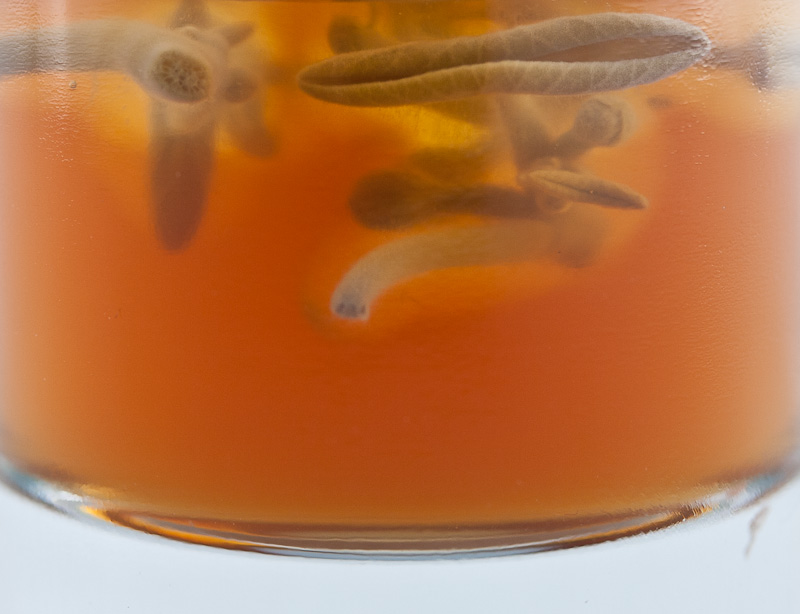
I’d almost – ALMOST — resigned to myself that if there would be one recipe that I completely failed it, this would be the one. The irony is that this recipe is laughably simple, save one extremely-rare and exotic ingredient that I’ve been trying to find off and on for a couple of years.
Junsai, or “water shield”, is a Japanese delicacy harvested from the water-lily-like plant Brasenia schreberi. Specifically, it is an underwater-growing organ system that produces roots and flower buds for the plant. Junsai is harvested as a vegetable in Japan, and is distinctive for a thick, invisible gelatinous mucilege that covers the flower buds.
I’ve been to almost every Japanese, Chinese, and Korean food market in the bay area looking for Junsai. The photos in the cookbook are pretty but aren’t terribly illustrative of what I should have been looking for, and of course the recipe gives no description. The Alinea At Home blog noted it’s a type of mushroom, which confounded my search for a good long time before I finally figured out it was actually something a bit more exotic. Asked about Junsai at various asian markets, employees either shrugged it off completely with an “I have no idea” or, if I got lucky, squinted at me Hattori Hanzo-style and said something like “Junsai. Yes, water-shield…very rare. Very hard to find. Why you want Junsai?” as if possessing this stuff would grant me immortality or something.
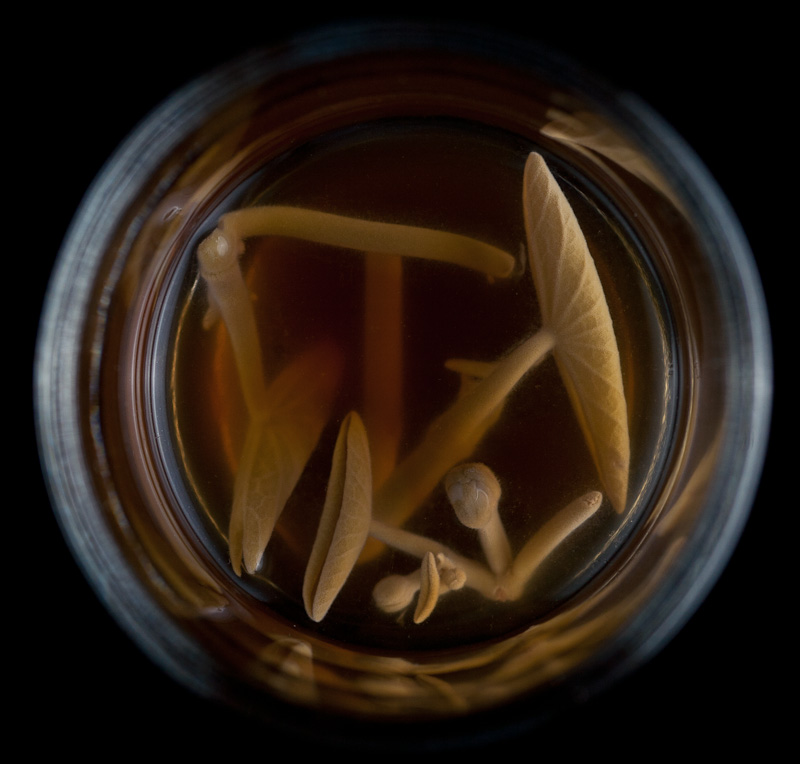
I asked on the Alinea Mosaic forums a long while ago, hoping one of the Alinea chefs might throw me some clues, but the question went unanswered until very recently, when Martin Lindsay of Alineaphile responded, asking if I’d had any luck. I passed him the clues I had, but admitted my search had turned up cold. A few days later, Martin excitedly responded:
I found some! A bit expensive at 8,00€ for the junsai + 28,00€ for shipping (US$42.42 total, for a 60ml bottle delivered to the US), but I found them! For sale online from a Japanese spice shop in Paris:
Workshop ISSé, Épicerie fine japonaise
11 rue Saint Augustin 75002 Paris
tél: +33 (0)1 42 96 26 74
Here’s a link to their website: http://bit.ly/n7aoLK
Much as I’d like to hope I might have found it all on my own eventually, I’m nevertheless incredibly thankful for Martin’s tenacity and generosity. If you read this and haven’t checked out his own progress working his way through the cookbook, I’d encourage you to. His blog is an incredibly useful resource for anyone attempting to work though this cookbook, and I refer to it often (in fact, that’s often why I’m lazy about including specific details…I figure anyone reading this also reads his blog, and he’s clearly got the ‘passing along awesome information’ base well-covered).
At any rate, poking the ‘buy’ button, despite not speaking French at all, was a no-brainer for me. A few days later, a tiny bottle showed up in the mail…I finally got to see Junsai in person.
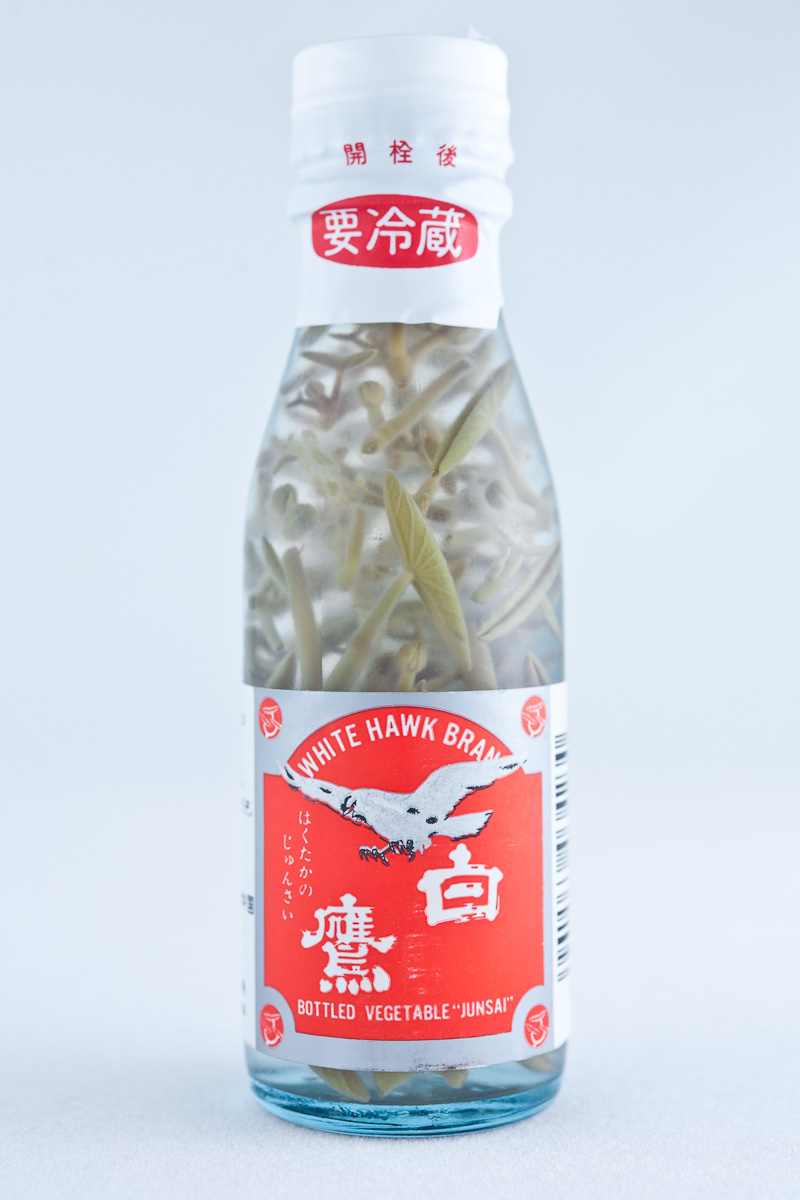
The first thing that struck me was what looked to be a zero-gravity environment going on inside the bottle. The Junsai weren’t touching each other…they appeared to be floating. I realized this was due to their ‘water shields’…gelatinous force-fields surrounding each tiny bud. I was so, so giddy to have clearly gotten ahold of the right stuff.
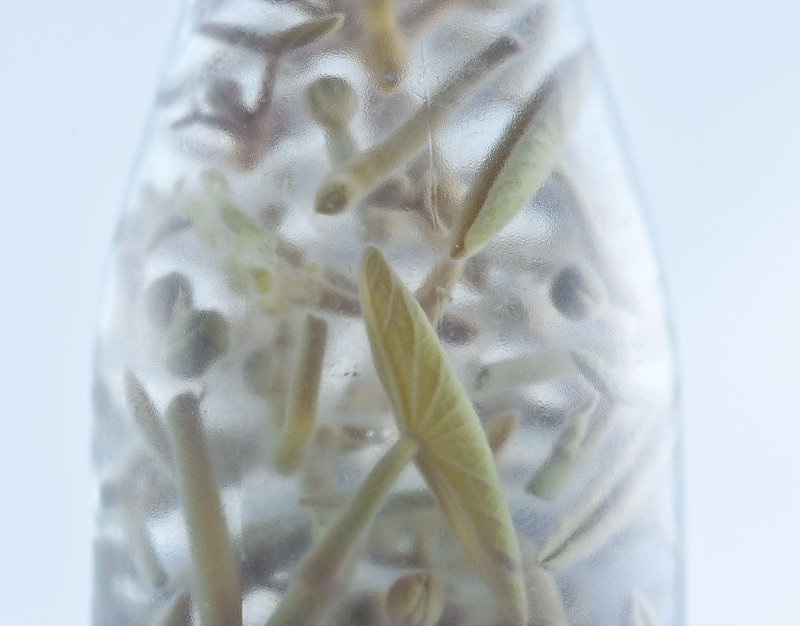
To help show the ‘water shield’, I put a Junsai into a little bit of colored water:
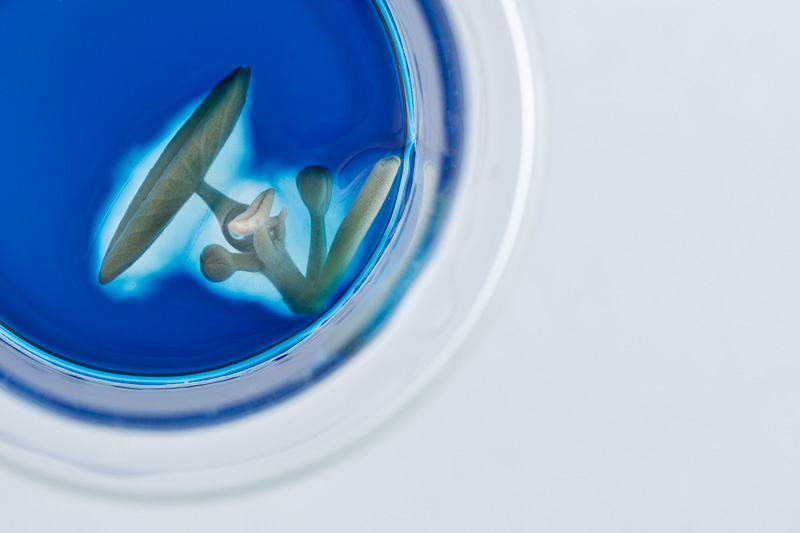
The ‘preparation’ of the Junsai is, literally, “Gently rinse in water”. Ok…done!
Next was to make some Dashi. I’d made Dashi once before, following an Alton Brown recipe, and ended up with some very weak-tasting brownish water. It was bland and mostly-tasteless, and that’s what I assumed Dashi was meant to taste like. Alinea’s motto might as well be “Blandness Is For Pussies” though, because this Dashi was incredibly punchy and flavorful and assertive.
I started with a dried sheet of kombu (dried seaweed), left to soak in water overnight.
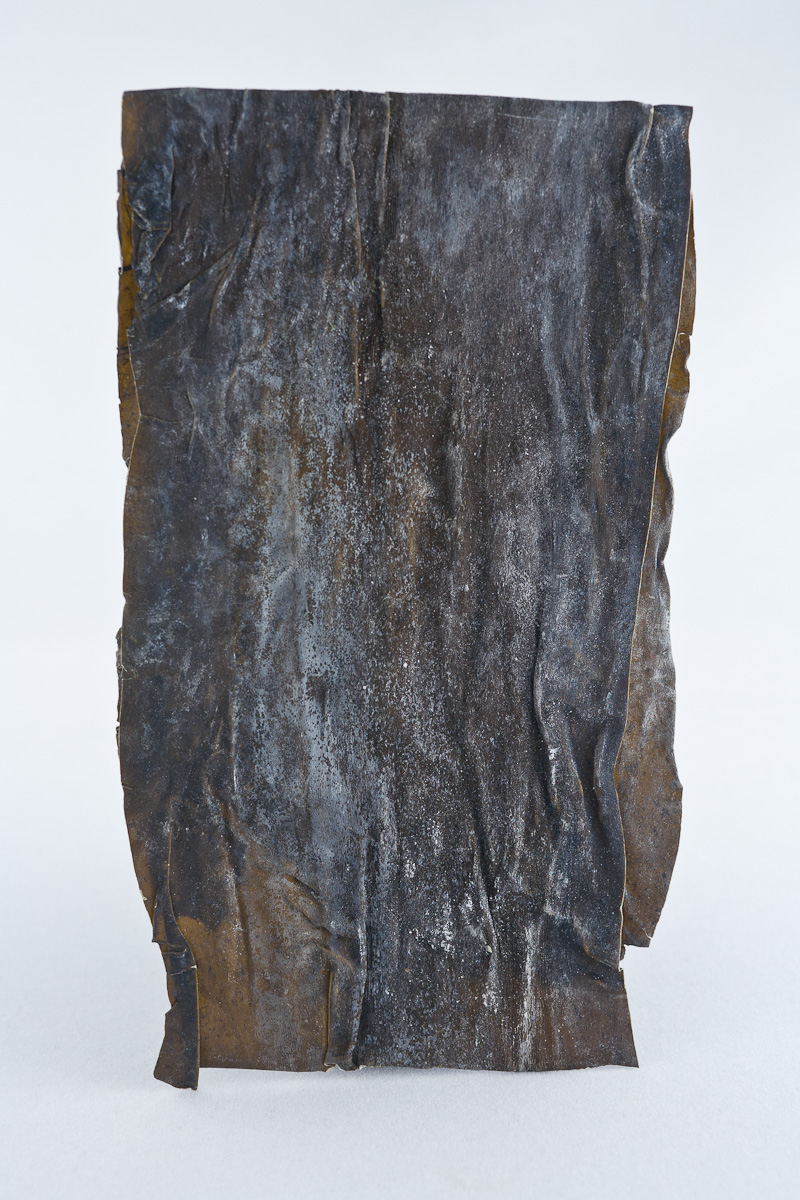
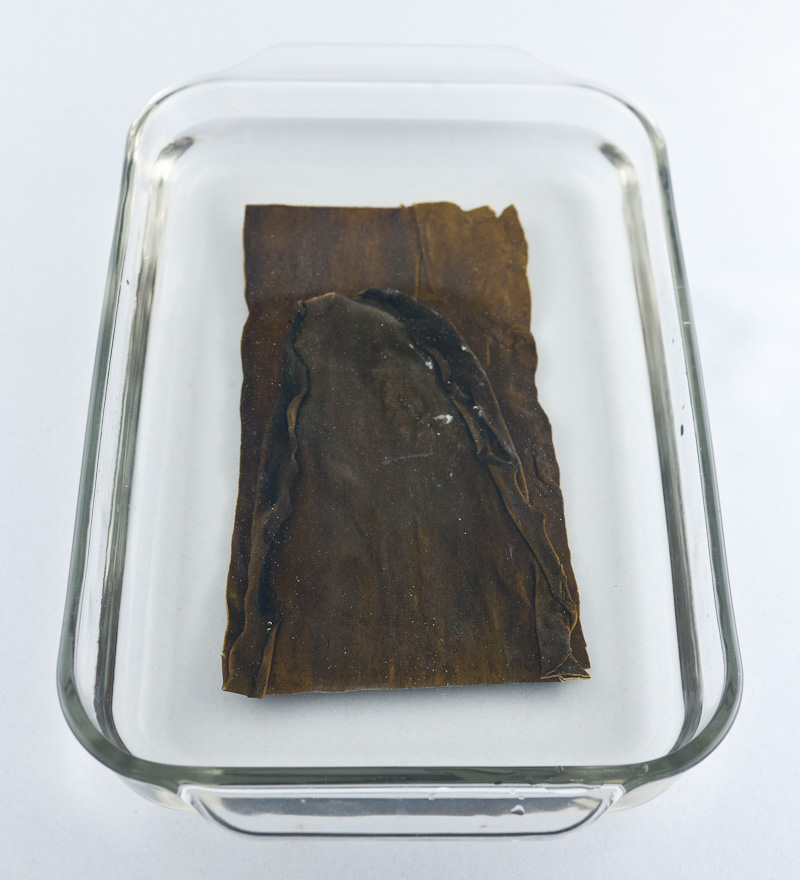
The next day, I simmered the drained kombu in water, strained off the broth, and added 100g of bonito (a fish that has been smoked, dried, and shaved into katsuobushi, which looks like this):
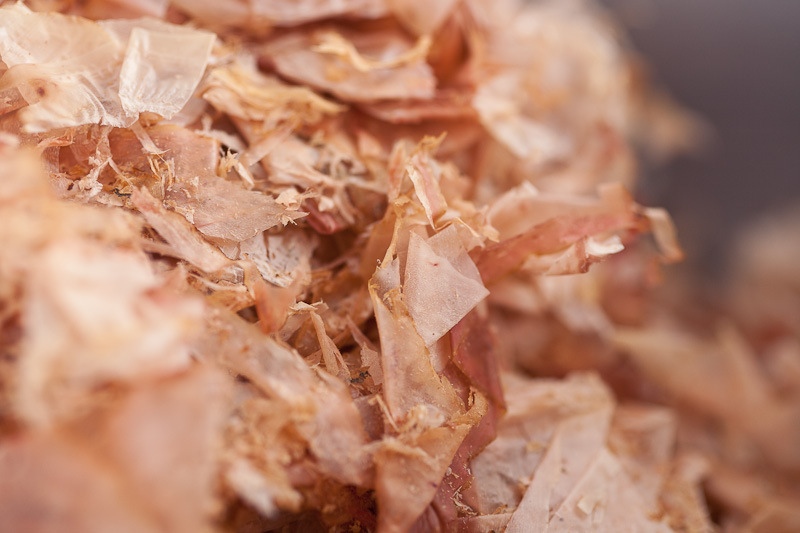
I let this mixture drain through a coffee filter, added some soy, mirin, and rice vinegar, and chilled it for a day in the fridge.
That’s it. Add a few Junsai, and drink.
The flavor of the whole dish is that of the Dashi; the Junsai themselves are exactly flavorless. This means their attractiveness lies in their texture, which this dish seeks to highlight. When they first hit your mouth, they’re slippery and roll around in a way that might cause some people to squirm. As you continue to roll them around, the water shield breaks apart and the interior roots/buds have a lovely vibrant crunch/pop to them. Sort of like ‘inverted caviar’. They’re neat, and I can say I’ve had them and liked them, but I can’t say my life is changed the way, say, my first truffle experience changed it. What I’d take away from this dish most easily though is the dashi. It’s powerfully delicious, especially when sipped chilled, and Sarah and I agreed we could drink this stuff all day.
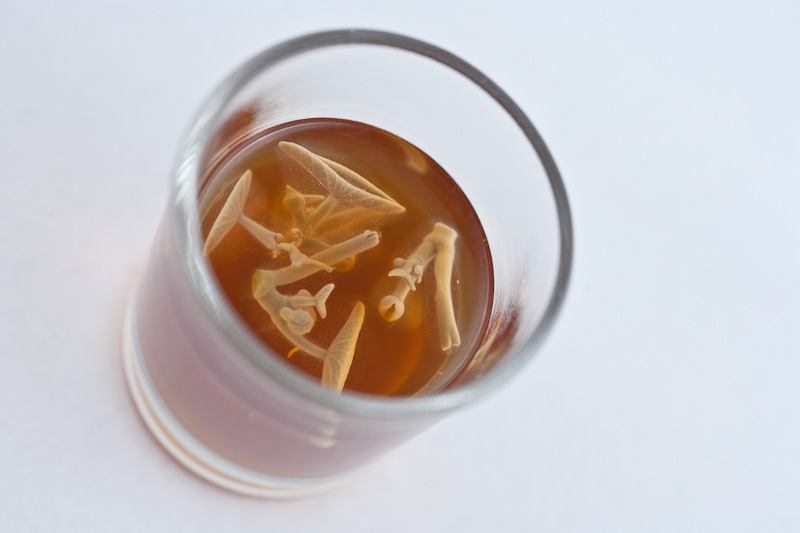
I have to say, this dish looks more like something you’d find at the back of a dusty cupboard in some high school laboratory alongside formaldehyde-drenched frogs or something, but I’m glad you found your junsai.
What I’m really interested in is this dashi. I mentioned awhile ago that I was planning on making fresh ramen from scratch, and I haven’t yet, mostly because I realized that the dashi that the ramen would be served with was at least as important as the ramen themselves. You don’t go into much detail about the process here, so I was wondering whether you could elaborate a little. (I haven’t been able to find much that looks very credible about making dashi on the internet.) I’d experiment on my own, but kombu, dried shiitakes, etc. are surprisingly expensive. So, how long would you recommend simmering the kombu for, and is there a specific temperature that it should be simmering at? Somewhere in the first issue of Lucky Peach, someone mentions a precise temperature for optimal glutamate extraction (so I’m wondering whether the Alinea recipe corroborates that). Also, if you have any advice about seasoning the dashi with soy, mirin, etc. that would really be helpful.
Hi Katie;
Before I elaborate too much, I should point out that Sarah and I had some soba noodles with mushrooms and the leftovers of this dashi, and found that we were both full after maybe 1/3 of a bowl. It’s SO rich, and clearly meant to pack a powerful and flavorful punch when enjoyed in one bite (as the recipe prescribes). So, while the flavor is nice, I would dilute it before trying to make a meal out of it.
The recipe suggests soaking kombu overnight, then simmering it for around 20 minutes. There’s no mention of temperature, but a simmer is just under boiling, so around 210F or so I reckon. After the simmering, I strained out the kombu, added a lot of bonito, then immediately strained the mixture through a coffee filter (this takes a while, and is a step included to ensure a very clear final broth. You could just use a strainer if you don’t care much about clarity). I used soy, mirin, and rice vinegar to season it (I think it was something like a ratio of 2:1:1 soy/mirin/rice vinegar), but how much of all of them you use would be dependent on how much water you started with. There weren’t any mushrooms involved in the Alinea recipe, though when I made soup with the leftover dashi I used some maitake mushrooms and that tasted pretty nice (I’m allergic to shiitakes).
Good luck!!
Thanks, Allen. You’re always a big help. Hopefully I’ll get around to this soon. I’m trying to piece together a vegetarian dashi based on something suggestive in Lucky Peach that’s never spelled out as a recipe. I guess I’ll just have to taste as I go.